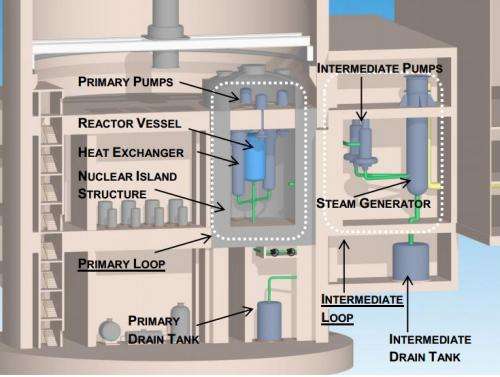June 21, 2014 weblog
Molten salt reactor concept has new Transatomic Power lift

Transatomic Power has been in the news this month in its ambition to build a better reactor. The Cambridge, Massachusetts-based Transatomic Power has proposed a safer reactor that "eats nuclear waste," as Bloomberg.com put it. The company sees potential in an innovative nuclear reactor that can turn nuclear waste into a safe, clean, and scalable source of electricity. A detailed report on their company goals in IEEE Spectrum described how cofounders Leslie Dewan, now Chief Science Officer, and Mark Massie, Chief Technology Officer, thought of the idea in 2010, while working on their PhDs in nuclear engineering at MIT; namely, they were thinking of a better reactor addressing the nuclear industry's big headaches, waste and safety.
Dewan and Massie met Russ Wilcox, now CEO, and the company Transatomic Power became a reality in 2011.Transatomic Power has focused on an innovative molten salt reactor, which, they said, can safely burn nuclear waste to deliver affordable clean energy. Molten salt reactors are not a new discovery. They were originally developed and tested at the Oak Ridge National Laboratory in the 1950s, 1960s, and 1970s. In a white paper prepared in March this year, the team discussed the story of molten salt reactors, also noting that advocates of thorium and increasing demand for small modular reactors drove renewed examination of molten salt in the 1990s. In 2002, the Generation IV International Forum (GIF) reviewed about100 of the latest reactor concepts and chose molten salt reactors as one of the six advanced reactor types most likely to shape the future of nuclear energy, "due to advances in sustainability, economics, safety, reliability and proliferation-resistance."
What's new here? They said Transatomic Power improved the molten salt concept, while retaining its safety benefits.
"The main technical change we make is to change the moderator and fuel salt used in previous molten salt reactors to a zirconium hydride moderator, with a LiF-based fuel salt. During operation the fuel in the salt is primarily uranium. Together, these components generate a neutron spectrum that allows the reactor to run using fresh uranium fuel with enrichment levels as low as 1.8% U-235, or using the entire actinide component of spent nuclear fuel (SNF). Previous molten salt reactors such as the ORNL Molten Salt Reactor Experiment (MSRE) relied on high-enriched uranium, with 33% U-235. Enrichments that high would raise proliferation concerns if used in commercial nuclear power plants."
Dewan said their reactor would be "walk-away safe," according to IEEE Spectrum. "If you don't have electric power, or if you don't have any operators on site, the reactor will just coast to a stop, and the salt will freeze solid in the course of a few hours," she said. Eric Roston, sustainability editor for Bloomberg.com, discussed more advantages. "Molten salt reactors can tap more energy in fuel and use it for decades, compared with four or five years in reactors today. That means they need less enriched uranium, reducing the risk of fuel being stolen to make bombs. Transatomic's reactor would cost half as much per gigawatt of electricity as conventional reactors, Dewan says."
Overall, according to the company, "Transatomic Power's advanced molten salt reactor … solves four of the most pressing problems facing the nuclear industry: ecological stewardship, public safety, non-proliferation, and cost-efficiency."
More information: transatomicpower.com/
© 2014 Tech Xplore


















